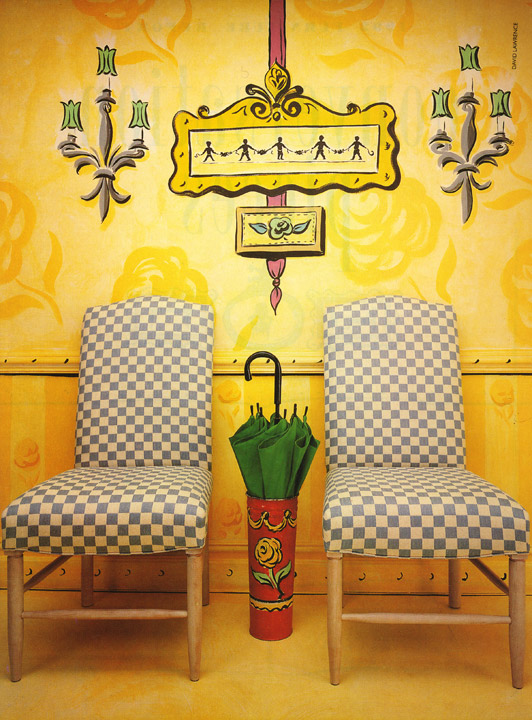One of the intriquing things about this display is that the frames and the product are attached to a clear plexi wall so they appear to magically float in the display space.
Thursday, June 20, 2013
Throwback: Estee Lauder vitrines
Geoff has doing the Estee Lauder executive conference room vitrines for many (many) years. Among some of his favorites was this installation, designed in collaboration with the vice president of visual merchandising. Using gold-leafed poseable wooden 'artist's models' at an exhibition where the latest Estee Lauder product was the art. It's also an homage to the Lauder family's famous art collection and their extraordinarily generous support of museums worldwide.
One of the intriquing things about this display is that the frames and the product are attached to a clear plexi wall so they appear to magically float in the display space.
One of the intriquing things about this display is that the frames and the product are attached to a clear plexi wall so they appear to magically float in the display space.
Thursday, June 13, 2013
Throwback: Conversation Pieces
Back in the late 20th century, Brides Magazine was a highly regarded and creative magazine with many special features on home decor and tabletop design. Working closely with the creative director at the time, Geoff was asked to design the layout for this 5 page spread creating painted backdrops, and some of the furniture, in Geoff's own light-hearted and fanciful style.
Labels:
1992,
Brides Magazine,
decorative painting,
editorial,
Geoff Howell,
illustration
Wednesday, June 5, 2013
The "Three Parlors" exhibition at Lyndhurst Mansion
Here's a look at a new exhibit GHS just completed installing recently at Lyndhurst National Trust Historic Site, in Tarrytown, New York.
In collaboration with the new and fantastic director, the furniture was selected, and the exhibition was designed and produced by Geoff Howell Studio, which built the walls, the risers, installed all of the contents of the show, and lit them, all in the old Carriage House on the property. Geoff also designed and produced a gothic arch based on the architecture of the house, which is the surround for the signage at the entrance to the exhibit.
 |
| Arch custom made with layered mdf |
The exhibition will be there for your viewing pleasure all summer, and is just the tip of the iceberg of extraordinary design overload.In conjunction with the magnificent mansion and grounds, freshly refined and recharged, it is well worth the trip!
The exhibit features furniture and other pieces that are original to the house from the mid 19th century in the Rococo Revival style, all in rosewood and ebony, (one signed by J. Meeks, a notable New York furniture maker), and then again in the 1870's in the Renaissance Revival style preferred by then owner uber rich financier Jay Gould. ( there is a black and white period photograph of the room included below)
Most notable are the Herter Brothers pieces, (some in salmon colored upholstery, a table with elaborate inlay work, small lacquered and gilt chairs, mirror, easel, etc ) the Herter Bros. were considered among the very best interior and furniture designers of their time (one large matching piece of this suite is on loan to the Metropolitan Museum of Art). They were the designers of many important interiors of the day, including the Vanderbilt's opulent over-the-top Fifth Avenue home, and work at the White House.
Also of note are the stained glass windows, attributed to another 19th century design star, John La Farge, and a large landscape by Courbet. Included from the house are some fine old paris porcelain vases, a very delicate bronze statue, some marble sculptures, a large persian carpet, and some later Aesthetic Movement japanese-inspired Herter Brothers pieces. it was quite an honor to work with such amazing objects!
 |
| The Herter suite, and the large Courbet landscape hanging on the wall to the left. |
 |
| detail of table top inlay |
 |
| A delicate gilt and inlaid Herter side chair. |
 |
| A period photograph of the Merritt Parlor showing the furniture on exhibit, in its original arrangement. |
 |
| The Rococo Revival Merritt suite from the 1850's, all made of rosewood solids and veneers. |
 |
| Detail of the marble topped rosewood Merritt center table |
 |
| The Benzoni sculpture of Cupid and Psyche purchased by the Merritt's around 1851, at the Crystal Palace Exhibition in London. The other two sculptures are from the same period. |
 |
| Ebony table to the left, the signed Meeks piece in the middle, marble topped rosewood music cabinet, bronze, all purchased by the Merritts. |
 |
| Close-up of the detail in the solid ebony side table. |
 |
| Set of four rosewood side chairs from the Merritt Parlor. |
Labels:
19th century,
Aesthetic Movement,
Benzoni,
Courbet,
Herter Brothers,
J. Meeks,
Jay Gould,
John LaFarge,
Lyndhurst Mansion,
Merritt,
museum exhibitions,
Rococo Revival,
Tarrytown
Tuesday, June 4, 2013
Many Armani
Always a study in the precise and geometrical, this Armani installation is no exception. Using Ombré-d printed plexi-glass, each row of shingles were meticulously cut-out by computer and applied to the face of a large light-box fading from dark turquoise to a lighter shade at the bottom. Because of the angle at which the shingles are placed, light glows from in between the rows. And because of the highly reflective surface of the plexi glass lights from many other sources reflect in the shingles and create a sparkling effect as you walk by.
Labels:
Armani,
Geoff Howell Studio,
New York City,
store windows,
visual merchandising,
window design,
window display
Subscribe to:
Posts (Atom)























